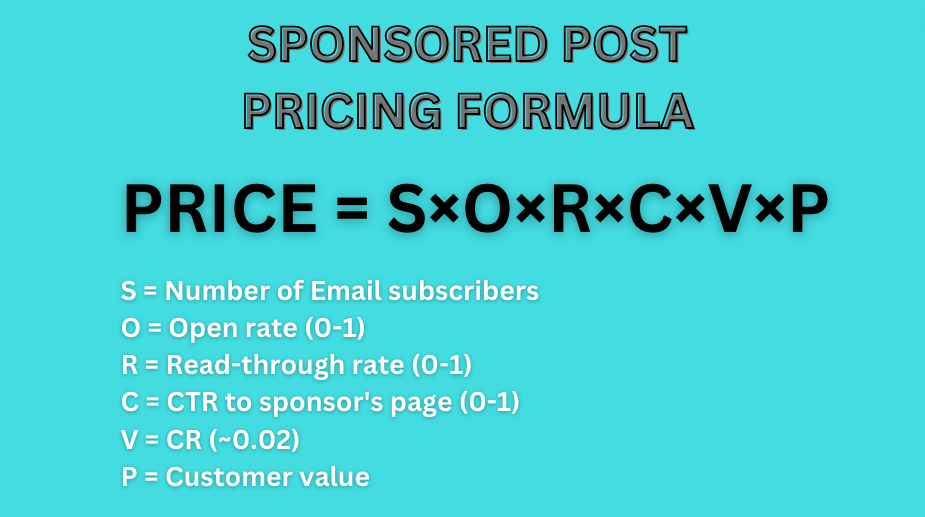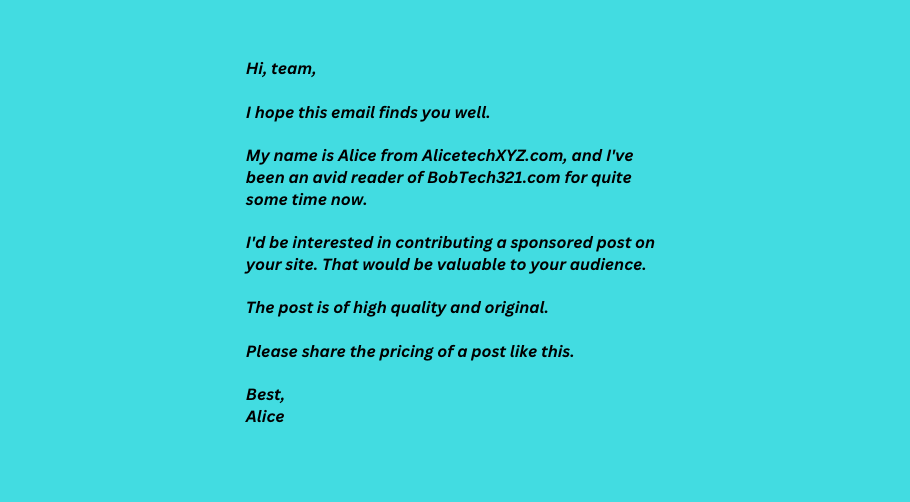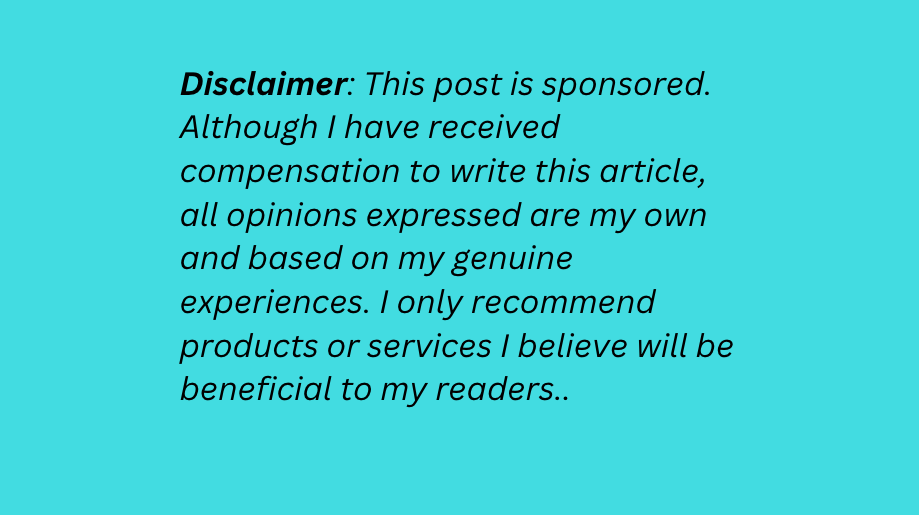Charging for a sponsored post is all about reader engagement.
A blog that doesn’t have an active email list can’t usually charge anything for a sponsored post.
This is because publishing a sponsored post on a blog page isn’t going to draw any visitors even with a huge monthly traffic.
You either need to promote it to your mailing list or social media followers.
At the end of the day, the company wants to get a return on investment with those sponsored posts.
If you charge $100 for a post, the company should expect to make more than that.
Sponsored Post Pricing Formula

A very naive way to calculate the pricing of a sponsored post looks like this:
PRICE = S×O×R×C×V×P
Where:
- S = Your Email Subscriber List Size
- O = Email Open Rate (range: 0-1)
- R = Read-through Rate (range: 0-1)
- C = Click-through Rate to the sponsor’s website (range: 0-1)
- V = Estimated Typical Conversion Rate (Usually about 0.02)
- P = Typical customer value (i.e. how much they will roughly pay on average)
But notice that there are dozens of factors that can have an impact on sponsored post pricing.
These include:
- Niche
- Audience engagement
- Email list size
- Social following size
- Promotion strategies
Thus, the above equation can give you a very rough idea. But it’s much wiser to consider the pricing more carefully case-by-case basis.
For example, in the investment niche, an average customer can be worth thousands of dollars.
But in a niche like e-games, an average customer might just be worth a couple of bucks.
Example
Let’s run a realistic example with typical numbers.
An online course platform approaches you to do a sponsored post to promote their $50 courses. Assume your blog has 100,000 email subscribers and an open rate of 50%.
How much should you charge for the post?
Answer:
Let’s convert percentages to fractions (and do some assumptions because not all numbers were given in the assignment):
- S = 100,000
- O = 50% → 50/10 = 0.5
- R = Assume 20% of people read the whole post → 20/100 = 0.2
- C = Assume 10% of readers click on the sponsor’s page → 10/100 = 0.1
- V = Estimated Typical Conversion Rate = 0.02 (industry standard)
- P = Typical customer value. Let’s assume $50 as it’s the price of the course.
Let’s take a calculator and run the numbers!

Sponsored post price = 100,000×0.5×0.2×0.1×0.02×$50
= $1,000
So you should charge $1,000 for a sponsored post to your 100,000 email subs.
As you can see, you need a huge audience to make a notable amount of your post.
More Detailed Explanation
If you hate equations like the above, here’s a less math-heavy, and more verbal way to figure out the pricing to the above example.
If you promote the sponsored post to your 100,000 email subscribers with 50% opening the post, the post will be seen and noticed by 50,000 people.
If 20% of those read the post, that makes 10,000 reads.
If 10% of the readers move to the website of your sponsor, that makes 1,000 clicks.
Then, let’s assume the company has a conversion rate (buys/visitors rate) of 2%, which is typical in many niches.
This means 20 customers.
So your post just brought in $1,000 for the sponsor.
Thus, the pricing of the post should be at most $1,000.
The Problem with the Equations
The problem is that there are simply too many factors to consider when it comes to creating an equation for sponsored post pricing.
It’s not science.
It’s actually much better to just test things around, ask for people in your community, and go with the gut feeling.
Typically, your sponsor will ask for numbers related to engagement and email subscribers. They can estimate what’s a good price for a post.
You can then counter based on your gut feeling and factor in extra expenses (the time it takes to proofread, edit, publish, and email back and forth).
Nonetheless, you need a huge email list to make anything significant from a sponsored post!
99% Of Sponsor Post Requests Are Scams, Though
Be aware!
Most “sponsors” are fake—even if they paid you.
If the sponsor doesn’t ask about engagement numbers, email subscribers, or monthly traffic, they’re illegitimate.
They’re only interested in placing a link to your website—which is both illegal and against Google’s policies.
Typically, those emails look like this:

If you have accepted a sponsored post from a company like this, you need to go ahead and edit those posts right away!
Mark the sponsored links as “no-follow” and “sponsored” to comply with Google’s policies.
Then you need to add a short disclaimer to the beginning of the post that this is a sponsored post.

Here’s a post where I show you how to do it.
The reason why those “fake sponsors” approach you is actually quite tricky to explain and thus hard to spot.
To put it short, they want to gain an illegitimate SEO advantage.
A longer explanation is that they want to buy a link from your site to another. This link will then trick Google to believe that the “sponsor’s” website is more trustworthy than it actually is. This, in turn, helps the “sponsor” to rank higher on search results.
The problem with this is that it’s cheating and against Google guidelines. And those undisclosed deals are actually also illegal!
So basically, the “sponsor” wants you to be part of a link-building scheme. Not good!
Sponsored Posts Aren’t Effective, Anyways!
Sponsored posts are almost always ineffective when it comes to blogging.
This is because people don’t read every blog post that the blog has. Instead, most people just come and go.
So having a ton of monthly visitors is not what interests the sponsor (or at least it shouldn’t).
The exception is if you’re a popular person that has started a blog and your readers are your fans that hit refresh on your blog’s archive page every 15 minutes.
But 99.9% of the blogs won’t fall into this category.
For most of us bloggers, if someone lands on your blog from Google results, they will bounce as soon as they’ve found the answer.
While a blog like this is doing exactly what it should, this is not ideal for sponsored content.
Most visitors have no interest in scrolling through your blog archive page or frontpage, or anything else where the sponsored posts would be found.
Thus, the only real way to get visitors to a sponsored post is by sharing it through email lists and social media.
And if you don’t have thousands and thousands of followers/subs, this won’t bring any benefit to the sponsor.
Also, one thing about sponsored content promotion is that it “exhausts” your audience. Send 10 sponsored posts in a row and nobody will ever read your emails ever again.

You can obviously factor this into your pricing, but remember, the sponsor is after a return on investment.
What to Do Instead of Sponsored Posts?
I always suggest affiliate marketing instead of sponsored content.
This is great for both parties.
The sponsor doesn’t need to pay in advance. They will only pay if you manage to sell something.
Affiliate marketing is a highly-converting strategy that can yield really nice income.
For example, I have a blog post that promotes AI image generator tools and has earned more than $20,000 in affiliate revenue with a bit less than 1,000,000 page views.
Of course, these types of numbers aren’t typical.
But it goes to show that promoting the right types of products for the right type of audience can be much better than doing sponsored posts.
Thanks for reading. Happy writing!
